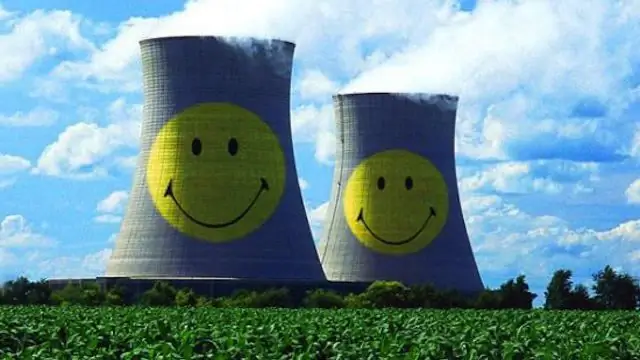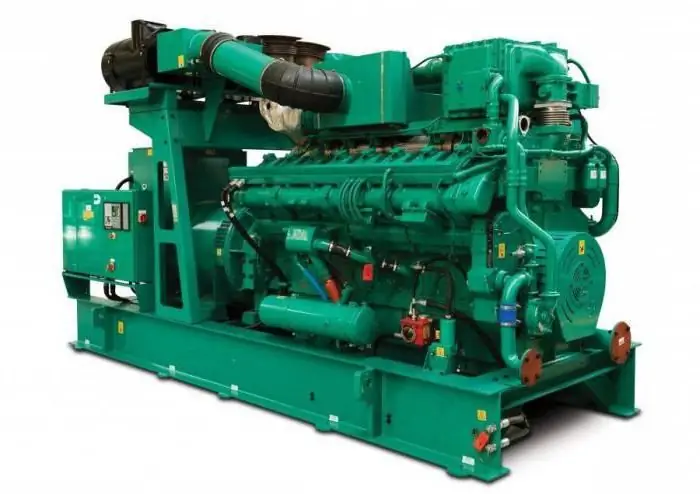2025 Author: Howard Calhoun | [email protected]. Last modified: 2025-01-24 13:10:47
For the functioning of industrial and economic facilities located at a considerable distance from the centralized power lines, small-scale power generating installations are used. They can operate on various types of fuel. Gas turbine power plants are the most widespread due to their high efficiency, ability to generate thermal energy and a number of other features.
Operation principle
The basis of a gas turbine power plant (GTPP) is a gas turbine engine - a power plant operating on the energy of combustion of gaseous fuel, mechanically connected to electric generators and combined with them into a single system. The gas turbine plant is the most powerful internal combustion engine. Its power density can be 6 kW/kg.

Unlike other types of powerinstallations, in gas turbine engines all processes take place in a stream of constantly moving gas. Atmospheric air compressed by compressors enters the combustion chamber together with fuel. The mixture ignites with the release of a large amount of combustion products under high pressure, which put pressure on the blades, rotate them, and with them the electric generators.
The capacity of a gas turbine power plant varies from 20 kilowatts to several hundred megawatts. Any combustible material that can be dispersed (finely ground) and presented in gaseous form can be used as a fuel.
GTPP advantages
An important advantage of gas turbine power plants is the possibility of simultaneous use of two types of energy - electrical and thermal. Moreover, the amount of heat given to the consumer is two to three times greater than the amount of electricity generated. Cogeneration (the process of generating two types of energy) becomes possible when a special waste heat boiler is installed on the turbine exhaust.

Using gas turbine power plants, it is possible to create autonomous energy complexes that can solve several problems at the same time:
- Provide electricity to private and industrial facilities.
- Utilize by-product gas from oil production.
- Heat technical rooms and residential buildings with side heat.
All this allows us to significantly reduce the cost of providing the enterprise, create optimal conditions for the work of personnel andconcentrate material resources and capital on expanding production and solving other, more important tasks.
Features of gas turbine power plants
One of the main features of the GTPP is the ability to operate on virtually any type of fuel. As noted earlier, gas turbine power plants can use fuel that can be dispersed to operate. This can be gasoline, fuel oil, oil, natural gas, alcohol, and even crushed coal.

There are practically no moving elements in the GTPP design. The only moving part that combines the generator rotor, turbine wheels and compress can be suspended using a gas dynamic bearing. As a result, the wear of working units will be minimized, which will significantly affect the durability of the installation.
At the same time, the period of service maintenance increases up to 60 thousand hours of continuous operation or up to 7 years of operation. Gas turbine power plants cannot be used as backup energy sources, because at the time of start-up, parts wear out especially intensively. The number of plant launches is limited to 300 per year.
Mobile GTES
A special place in the industrial sector is occupied by mobile gas turbine units. Unlike conventional GTPPs, they have smaller dimensions and weight, are equipped on a mobile platform and are equipped with electronic control systems. As a rule, such complexes are used forrestoration of power supply to the facility.

The mobile gas turbine power plant is deployed on paved sites that provide a stable position. A fuel line is connected to it, and a transformer substation is installed in the immediate vicinity. Deployment time depends on the type of installation, but usually does not exceed 8-12 hours.
The capacity of mobile units varies from 5 to 25 MW. At the same time, the efficiency of mobile GTPPs begins to grow from 35%. Like stationary power plants, mobile complexes also emit thermal energy. But at the same time, they create less costs associated with operation and commissioning.
Combined-cycle power plants
A steam-and-gas plant can be called a modification of a GTPP. Like gas turbine power plants, such generators use the energy of combustion of dispersed fuel. But passing through the turbine, gaseous products give up only part of their energy and are released into the atmosphere in a heated state. Combined-cycle plants use this heat.

The design of combined cycle power generators has a steam power plant, which is located in the end part of the turbine. It contains water that boils from the heated products of combustion. A huge amount of steam is generated, which turns the turbine and powers the additional generator.
Gas turbine and combined cycle power plants can be used in all industriesindustry, but the second type of generators is preferable, because their efficiency is more than 60%.
GTPS applications
The use of gas turbine plants is advisable for consumers remote from centralized power supply lines, as well as for seasonally functioning facilities. In this case, the cost of providing the enterprise with electricity will be lower than for connecting to power lines.
Large-sized GTPPs should be used instead of thermal power plants if there is a cheap source of fuel. This situation is typical for the oil and gas regions of the North. At the same time, it is possible to save on space heating.

Recently, mobile gas turbine power plant has become widely used in urban areas due to the low level of noise, vibration and toxicity of exhaust gases. It is advisable to use it in cases where it is difficult to connect to the city's power grid or the cost of the latter is too high.
Recommended:
Nuclear power plants. Nuclear power plants of Ukraine. Nuclear power plants in Russia

Modern energy needs of mankind are growing at a gigantic pace. Its consumption for lighting cities, for industrial and other needs of the national economy is increasing. Accordingly, more and more soot from burning coal and fuel oil is emitted into the atmosphere, and the greenhouse effect increases. In addition, there has been more and more talk in recent years about the introduction of electric vehicles, which will also contribute to the increase in electricity consumption
The largest power plants in Russia: list, types and features. Geothermal power plants in Russia

Russia's power plants are scattered in most cities. Their total capacity is enough to provide energy for the entire country
Energy gas turbine installations. Cycles of gas turbine plants

Gas turbine units (GTP) are a single, relatively compact power complex, in which a power turbine and a generator work in pairs. The system has become widespread in the so-called small power industry
Gas piston power plant: the principle of operation. Operation and maintenance of gas piston power plants

Gas piston power plant is used as a main or backup source of energy. The device requires access to any type of combustible gas to operate. Many GPES models can additionally generate heat for heating and cold for ventilation systems, warehouses, industrial facilities
Floating nuclear power plant "Akademik Lomonosov". Floating nuclear power plant "Northern Lights"

A new word in the use of peaceful atom - a floating nuclear power plant - innovations of Russian designers. In the world today, such projects are the most promising for providing electricity to settlements for which local resources are not enough. And these are offshore developments in the Arctic, and the Far East, and Crimea. The floating nuclear power plant, which is being built at the B altic Shipyard, is already attracting great interest from domestic and foreign investors

